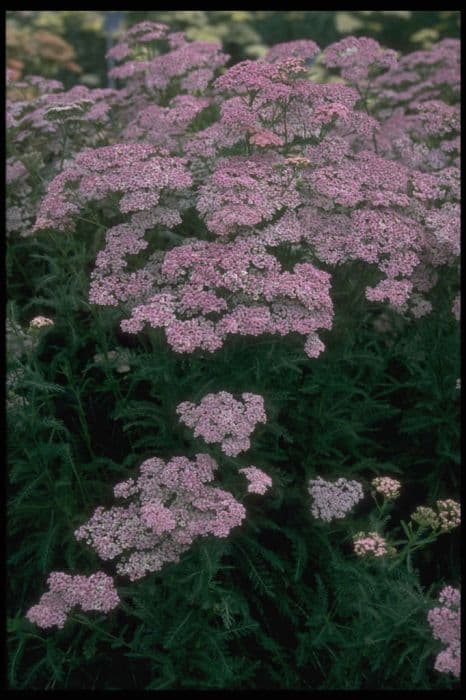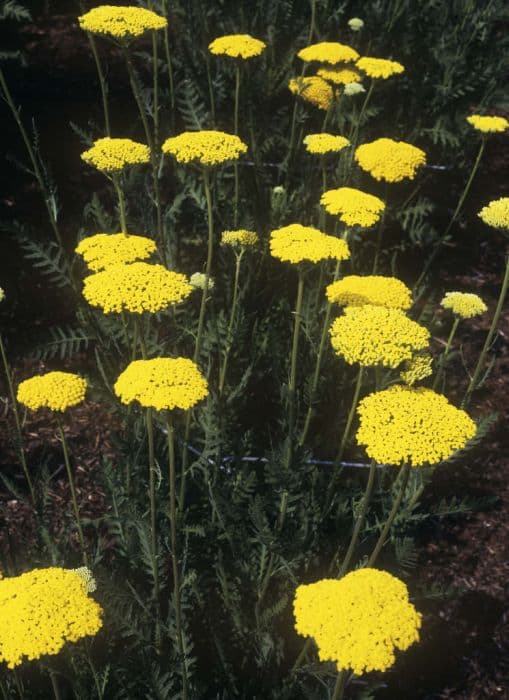Marguerite Daisy Argyranthemum Cherry Love = 'Supacher' (Daisy Crazy Series) (d)
![marguerite [Cherry Love]](/_next/image?url=https%3A%2F%2Fplants-admin.emdemapps.com%2Fimages%2Fplants%2F%2Fimages%2F604b57a49fb04.png&w=3840&q=75)
ABOUT
Argyranthemum Cherry Love, part of the Daisy Crazy Series, is a vibrant and attractive flowering plant. It features an abundance of daisy-like flowers with a unique and striking appearance. The blooms of this plant are a rich cherry-pink hue, boasting a bright, eye-catching color that commands attention in the garden. At the center of each flower, there is a distinctive darker eye that contrasts beautifully with the rays of petals that surround it. This dark eye adds depth and intricacy to the flower's appearance. The petals themselves are delicate and narrow, radiating outwards in a classic daisy form. They are arranged in multiple layers surrounding the center eye, creating a full and lush look that adds texture to the overall display. The foliage of Argyranthemum Cherry Love is also noteworthy, with deeply cut leaves that have a feathery appearance. The leaves are a rich green color, providing a perfect backdrop that makes the cherry-pink flowers stand out even more. Throughout its blooming season, this plant creates a generous display of flowers that can add a lively pop of color to any setting. Its overall appearance is both cheerful and elegant, making it a favorite for gardeners who want to incorporate a touch of romance and vibrancy to their landscape. The Argyranthemum Cherry Love is not only appreciated for its beauty but also for its ability to transform a garden or patio area with its dazzling and long-lasting blooms.
About this plant
 Names
NamesSynonyms
Marguerite Daisy, Paris Daisy, Cobbity Daisy.
Common names
Argyranthemum Cherry Love = 'Supacher' (Daisy Crazy Series) (d).
 Toxicity
ToxicityTo humans
The Marguerite daisy, commonly known by its botanical name Argyranthemum, does not have a notable level of toxicity to humans. These plants are generally considered non-toxic and safe around people. However, it's always advisable to avoid ingesting any part of ornamental plants as a precaution. While they are not known to be toxic, individual allergic reactions or sensitivities are always a possibility.
To pets
The Marguerite daisy is considered non-toxic to pets. While it is generally safe, ingestion of any plant material can potentially cause mild gastrointestinal upset in some animals due to the novelty and fiber content. Symptoms, if they occur, could include vomiting or diarrhea. However, the Marguerite daisy itself does not contain any known toxic compounds that would pose a risk of serious poisoning to pets if they ingest the plant.
 Characteristics
CharacteristicsLife cycle
Perennials
Foliage type
Evergreen
Color of leaves
Green
Flower color
Red
Height
1-2 feet (30-60 cm)
Spread
1-2 feet (30-60 cm)
Plant type
Shrub
Hardiness zones
9
Native area
Canary Islands
Benefits
 General Benefits
General Benefits- Attractive Blooms - Argyranthemum Cherry Love produces vibrant, cherry-red daisy-like flowers that can add a pop of color to any garden or landscape.
- Long Flowering Season - This plant has a long blooming period, often providing color from spring through fall, enhancing garden interest for an extended time.
- Drought Tolerance - Once established, it is relatively drought tolerant, making it suitable for gardens in dryer climates or for gardeners seeking low-maintenance plants.
- Attracts Pollinators - The bright flowers attract bees, butterflies, and other pollinators, supporting local ecosystems and aiding in the pollination of nearby plants.
- Compact Growth Habit - With its compact and bushy growth habit, it is ideal for borders, containers, and small garden spaces, providing structure without overwhelming other plants.
- Low Maintenance - Argyranthemum Cherry Love typically requires minimal care, making it an excellent choice for both novice gardeners and those with limited time.
- Versatility - It can be used in a variety of garden settings, including beds, borders, containers, and as a filler in mixed plantings.
- Deer Resistance - The plant is not a preferred food source for deer, reducing the likelihood of damage in areas where deer are a common nuisance.
 Medical Properties
Medical PropertiesThis plant is not used for medical purposes.
 Air-purifying Qualities
Air-purifying QualitiesThis plant is not specifically known for air purifying qualities.
 Other Uses
Other Uses- Photography Prop: Argyranthemum flowers can serve as vibrant subjects or backdrops for macro photography, showcasing their detailed petal structure and vivid hues.
- Handmade Paper: Incorporating dried Argyranthemum petals into papermaking can create visually appealing paper with natural textures and colors for crafts.
- Educational Tool: The plant can be used to teach children about the lifecycle of flowering plants, from seed to bloom and seed production.
- Art Supplies: Crushed petals of the Argyranthemum can be used as natural pigments for paints, offering an eco-friendly option for artists.
- Bookmarks: Dried Argyranthemum flowers can be laminated within bookmarks, providing a durable and decorative way to mark pages.
- Culinary Decoration: Although not for consumption, Argyranthemum petals can be used to decorate cakes and desserts, removed before eating.
- Floristry Training: The plant's structure and bloom form make it a good candidate for teaching flower arrangement techniques in floristry courses.
- Dye for Fabrics: The blossoms can be used to create natural dyes for coloring textiles, contributing to sustainable fashion practices.
- Hobby Craft: Pressed Argyranthemum flowers can be incorporated into scrapbooking, greeting cards, or decoupage projects for an added floral accent.
- Color Comprehension: The plant's variety of tones can help in teaching color theory, exploring primary, secondary, and complementary colors in nature.
Interesting Facts
 Feng Shui
Feng ShuiThe Marguerite Daisy is not used in Feng Shui practice.
 Zodiac Sign Compitability
Zodiac Sign CompitabilityThe Marguerite Daisy is not used in astrology practice.
 Plant Symbolism
Plant Symbolism- Innocence: As a daisy variety, Argyranthemum Cherry Love generally carries the symbolism of purity and innocence, often associated with classic white daisies.
- Cheerfulness: The bright and lively appearance of the daisy represents cheerfulness and positive energy, bringing a smile to those who receive them.
- New Beginnings: Daisies symbolize new beginnings and fresh starts, making them a perfect gift for someone embarking on a new chapter in their life.
- True Love: Daisies are also commonly associated with loyal love and commitment, reflecting the bond between two people that is unbroken and true.
- Beauty: The simple and understated beauty of daisies highlights the idea that beauty can be found in simplicity and modesty.
 Water
WaterMarguerite daisies, including the Argyranthemum Cherry Love, require thorough watering when the top inch of soil feels dry to the touch, typically about once or twice a week. Water at the base of the plant to avoid wetting the foliage, which can promote disease. The exact frequency depends on weather conditions and soil type, but generally, it's best to provide enough water to soak the soil to a depth of about 8 inches, which could be about 1 gallon for a mature plant. During hotter periods or if grown in containers, they may need more frequent watering. Always allow the soil to dry slightly between waterings to prevent root rot.
 Light
LightThe Marguerite daisy prefers full sun conditions, which means it should receive at least 6 to 8 hours of direct sunlight daily. An ideal location would be in an area that gets unobstructed sun for most of the day, such as a south-facing garden. If grown indoors, place it by a sunny window. However, in extremely hot climates, some afternoon shade will help prevent the foliage from scorching.
 Temperature
TemperatureMarguerite daisies thrive in moderate to warm conditions, with an ideal temperature range between 60 and 75 degrees Fahrenheit. They can tolerate a minimum temperature of about 50 degrees Fahrenheit, and maximum temperatures should not exceed 90 degrees Fahrenheit consistently. These daisies prefer a cooler period at night, which can enhance blooming and overall growth.
 Pruning
PruningPruning Marguerite daisies is essential for encouraging bushier growth and more profuse blooming. Deadhead spent flowers regularly to promote continuous blooming throughout the season. Perform a more substantial prune in early spring or late autumn to maintain shape and remove any woody or dead stems. Best to prune back by about one-third of the plant's size to keep it compact and healthy.
 Cleaning
CleaningAs needed
 Soil
SoilMarguerite Daisy prefers well-draining soil enriched with organic matter, aiming for a slightly acidic to neutral pH of 6.0 to 7.0. The best soil mix for Marguerite Daisy may include a combination of garden soil, peat, compost, and perlite or sand to enhance drainage.
 Repotting
RepottingMarguerite Daisies should be repotted every 1-2 years to refresh the soil and accommodate the plant's growth. It is best done in the spring or early summer.
 Humidity & Misting
Humidity & MistingMarguerite Daisy thrives in moderate humidity levels, typical of outdoor environments. There is no strict humidity requirement, but it should be consistent and not too dry.
 Suitable locations
Suitable locationsIndoor
Place in bright, indirect light and water when soil is dry.
Outdoor
Place in full sun to part shade, protect from harsh elements.
Hardiness zone
9-11 USDA.
 Life cycle
Life cycleThe Marguerite Daisy 'Cherry Love' begins its life as a seed, which when sown in well-drained soil and with ample sunlight, germinates within 7 to 14 days under ideal conditions. Seedlings emerge and gradually mature into young plants with the development of true leaves, which then grow into a bushy foliage form typical of the genus Argyranthemum. As the plant enters its flowering stage, it produces vibrant cherry-red flowers that continue to blossom throughout the growing season, provided it receives proper care including regular deadheading to encourage more blooms. Following the blooming period, if the flowers are allowed to set seed, it completes its reproductive cycle, although many cultivars are often sterile and do not produce viable seeds. At the end of the growing season in colder climates, the Marguerite Daisy 'Cherry Love' may die back, especially if exposed to frost, since it is perennial only in USDA zones 10-11 and treated as an annual elsewhere. For continued growth, gardeners can propagate the plant through cuttings in the late summer to maintain its presence in the garden, or new seeds or plants must be acquired each season.
 Propogation
PropogationPropogation time
Spring to Summer
Propogation: The Argyranthemum 'Cherry Love' from the Daisy Crazy Series, known commonly as Marguerite Daisy, is generally propagated through cuttings. The most popular method involves taking stem cuttings of about 4 to 6 inches (approximately 10 to 15 cm) long from a healthy parent plant. These cuttings should have a few leaves at the top and the lower leaves should be removed. The cut end is then dipped in rooting hormone powder to facilitate root growth before being inserted into a moist potting mix. The pot should be kept in a warm, indirect light environment until roots develop, which can take several weeks. During this time, the medium should be kept consistently moist but not waterlogged to prevent rot. Once the cuttings have rooted and show signs of new growth, they can be transplanted into individual pots or directly into the garden.









